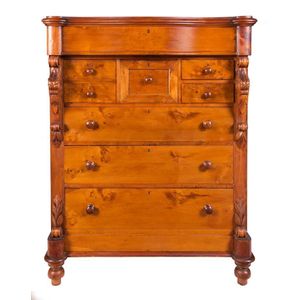Huon Pine Chest of Drawers with Carved Pilasters
You must be a subscriber, and be logged in to view price and dealer details.
Subscribe Now to view actual auction price for this item
When you subscribe, you have the option of setting the currency in which to display prices to $Au, $US, $NZ or Stg.
- Turned Legs - are legs which have been turned on a lathe. In use from the 16th century, turned legs on tables, chairs and cabinets became more frequent until, by the 1830s, the Georgian square or tapered leg was rarely found except in country pieces.
- Pilasters - In furniture a pilaster is a flattened column-like detail
applied to furniture. It is similar to a pilaster in architecture, but it is
typically smaller and less ornate. Pilasters are often used to decorate the
fronts of bookcases, cabinets, and other pieces of furniture. Pilasters can be
made of wood, metal, or other materials. They can be fluted, carved, or plain.
Pilasters are often used to add a touch of elegance and sophistication to
furniture. - Huon Pine - Named after the Frenchman who discovered the Huon River in Tasmania, it is an extremely slow growing and long living tree. Huon pine is native to Tasmania, and it can grow to an age of 3,000 years or more. The wood contains oil that retards the growth of fungi, hence its early popularity in ship-building in convict-era Tasmania. The timber is a warm yellow colour, finely grained, and was popular for household furniture in the Victorian era. Interestingly, much Huon pine furniture was made in South Australia. Huon pine is a protected species and only limited quantities are available nowadays, for craftsmen to manufacture small items such as platters, sculptures and other decorative objects.
- Serpentine - Resembling a serpent, in the form of an elongated 'S'. A serpentine front is similar to a bow front, except that the curve is shallow at each end, swelling towards the middle. The term presumably derives from its similarity to a moving snake or serpent. Serpentine fronts are usually veneered, with the carcase either being cut and shaped from a solid piece of timber, or built in the 'brick' method.
- Turning - Any part of a piece of furniture that has been turned and shaped with chisels on a lathe. Turned sections include legs, columns, feet, finials, pedestals, stretchers, spindles etc. There have been many varieties and fashions over the centuries: baluster, melon, barley-sugar, bobbin, cotton-reel, rope-twist, and so on. Split turning implies a turned section that has been cut in half lengthwise and applied to a cabinet front as a false decorative support.
This item has been included into following indexes:
- chests of drawers, material
- chests of drawers, period - Victorian 1,167
Visually similar items

A huon pine eight drawer chest with serpentine front and carved corbels, Circa 1870. 151 cm high, 122 cm wide, 59 cm deep

A George II burr walnut chest on chest, circa 1750 the shaped cornice above two short and two long drawers, the lower section with three long drawers, all cross banded, reeded and canted corners, brass handles and escutcheons, on bracket feet 168 cm high,

A large Victorian mahogany chest of drawers, mid 19th century, with an ogee frieze drawer and a trio of conforming deep drawers above three full length cockbeaded drawers of graduating depth, with turned handles and three-quarter length barley twist column

An interesting Art Nouveau floral decorated ten drawer pokerwork chest. 141 cm high, 59 cm wide, 27 cm deep
